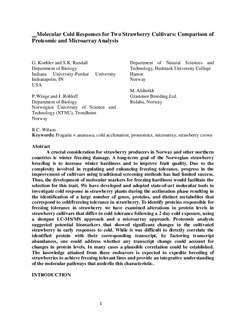| dc.contributor.author | Koehler, Gage | |
| dc.contributor.author | Randall, Stephen K, | |
| dc.contributor.author | Rohloff, Jens | |
| dc.contributor.author | Winge, Per | |
| dc.contributor.author | Wilson, Robert | |
| dc.contributor.author | Alsheikh, Muath | |
| dc.date.accessioned | 2019-11-05T09:55:01Z | |
| dc.date.available | 2019-11-05T09:55:01Z | |
| dc.date.created | 2010-08-30T22:34:48Z | |
| dc.date.issued | 2012 | |
| dc.identifier.citation | Acta Horticulturae. 2012, 929 73-81. | nb_NO |
| dc.identifier.issn | 0567-7572 | |
| dc.identifier.uri | http://hdl.handle.net/11250/2626548 | |
| dc.description.abstract | A crucial consideration for strawberry producers in Norway and other northern countries is winter freezing damage. A long-term goal of the Norwegian strawberry breeding is to increase winter hardiness and to improve fruit quality. Due to the complexity involved in regulating and enhancing freezing tolerance, the progress in the improvement of cultivars using traditional screening methods have had limited success. Thus, the development of molecular markers for freezing hardiness would facilitate the selection work for this trait. We have developed and adopted state-of-art molecular tools to investigate cold response in strawberry plants during the acclimation phase resulting in the identification of a large number of genes, proteins, and distinct metabolites that correspond to cold/freezing tolerance in strawberry. To identify proteins responsible for freezing tolerance in strawberry we have examined alterations in protein levels in strawberry varieties that differ in cold tolerance following a 2 day cold exposure, using a shotgun LC-MS/MS approach and a microarray approach. Proteomic analysis suggested potential biomarkers that showed significant changes in the cultivated strawberry in a early response to cold. While it was difficult to directly correlate the identified protein with their corresponding transcript, by factoring transcript abundances, one could address whether any transcript change could account for changes in protein levels. In many cases a plausible correlation could be established. The knowledge attained from these endeavors is expected to expedite breeding of strawberries to achieve freezing tolerant lines and provide an integrative understanding of the molecular pathways that underlie this characteristic. | nb_NO |
| dc.language.iso | eng | nb_NO |
| dc.publisher | International Society for Horticultural Science (ISHS) | nb_NO |
| dc.subject | Proteomikk | nb_NO |
| dc.subject | Proteomics | nb_NO |
| dc.subject | Kuldetoleranse | nb_NO |
| dc.subject | Cold hardiness | nb_NO |
| dc.subject | Mikromatriser | nb_NO |
| dc.subject | Microarrays | nb_NO |
| dc.subject | Transkripsjon | nb_NO |
| dc.subject | Transcription | nb_NO |
| dc.title | Molecular cold responses for two strawberry cultivars: Comparison of proteomic and microarray analysis | nb_NO |
| dc.type | Journal article | nb_NO |
| dc.type | Peer reviewed | nb_NO |
| dc.description.version | acceptedVersion | nb_NO |
| dc.subject.nsi | VDP::Genetikk og genomikk: 474 | nb_NO |
| dc.subject.nsi | VDP::Genetics and genomics: 474 | nb_NO |
| dc.source.pagenumber | 73-81 | nb_NO |
| dc.source.volume | 929 | nb_NO |
| dc.source.journal | Acta Horticulturae | nb_NO |
| dc.identifier.doi | 10.17660/ActaHortic.2012.929.9 | |
| dc.identifier.cristin | 348714 | |
| dc.description.localcode | © 2012. This is the authors’ accepted and refereed manuscript to the article. | nb_NO |
| cristin.unitcode | 194,66,10,0 | |
| cristin.unitname | Institutt for biologi | |
| cristin.ispublished | true | |
| cristin.fulltext | preprint | |
| cristin.qualitycode | 1 | |
